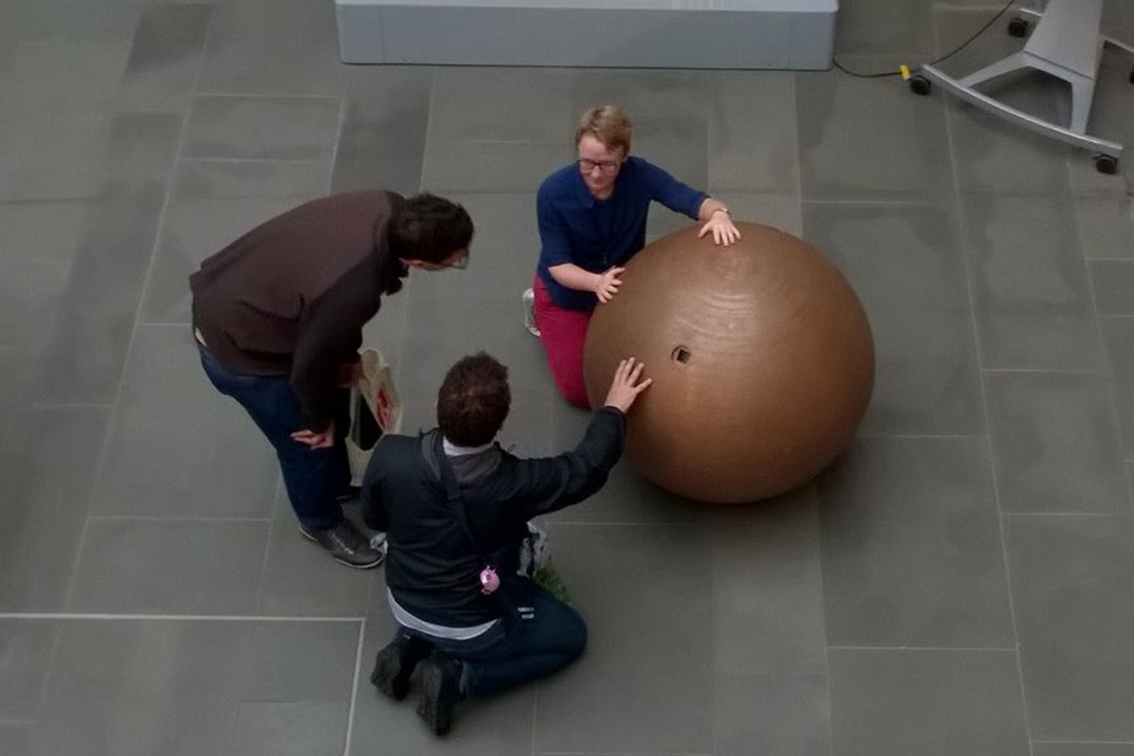What can we learn from 'damage'?
Megan Barford, Curator of Cartography shares her thoughts on hosting Globe at the National Maritime Museum.
In September 2017, Royal Museums Greenwich was delighted to host Globe. With its emphasis on people’s experiences and understandings of home, community and belonging, Globe offers certain themes which help pose questions about the Museum’s collection of almost 300 globes – the national globe collection in the UK, and one of the most important collections of historical globes in the world. The Museum’s globes were generally made to stay in one place: purporting to show the world; going nowhere. Globe’s is a geography of movement, one of traces gathered on the journeys she herself has made. With the project drawing on ideas of geography as ever-emergent and always situated, it offers an opportunity to think anew about some of the objects in our care: sometimes drawing contrasts, and sometimes bringing stories from the objects which might remain hidden. What follows are descriptions of three of the NMM’s globes and the worlds they came from or inhabited, all informed by questions Globe poses: whose journeys get traced? What can we learn from ‘damage’? What is the importance of an imagined future?
John Senex, Terrestrial Globe (1730): Tracing Journeys http://collections.rmg.co.uk/collections/objects/19825.html
In many ways, this 1730 English globe is the opposite of Globe. Most of its life it sat, protected by a tooled leather cover, in the large country house of Wimpole Hall, near Cambridge. The globe was owned by the Earl of Hardwicke (1690-1764), who was Lord Chancellor from 1737 to 1764. In the eighteenth century, globes – complex instruments which could be used to calculate the timings of celestial phenomena, and to measure terrestrial distances – were furniture in wealthy homes, helping the owners to show, and show off, their learnedness. This globe was used to that end in a family-specific way, showing the route of one of the most famous voyages of the mid-eighteenth century. The Earl of Hardwicke was the father-in-law of George Anson, a naval officer who became something of a celebrity when he sailed around the world in the 1740s, on a voyage which was intended to disrupt Spanish trading activities in the Pacific. Marked on this globe, over the printed surface and in a careful hand, is the route of Anson’s circumnavigation, the only journey marked on the object. It is a family geography of a famous voyage, incorporated into the way in which the British nobility brought a very particular global ideal into their homes.
Vincenzo Coronelli’s giant globe (1688; 1707; 1752) - Histories and Damage http://collections.rmg.co.uk/collections/objects/19810.html
How do objects show their histories? This is a key question in Museum work, but often we know very little about the life of an object before it enters the Museum. Globe records her journeys as she goes; sometimes I wish our globes had been able to do the same. Who has looked at them, or spun them? Who has used them to try to make calculations? Who has ignored them? The marks Globe gathers on her surface as she rolls provoke questions, about how what we see damage can show us more about the lives of objects. The Museum’s largest globe (108cm diameter; in its stand 150cm tall), with cartography by Venetian globe maker Vincenzo Coronelli, offers an interesting example. When, in the 1930s, the National Maritime Museum bought this globe, it had to be transported from Austria to London. Somewhere in transit, the globe was dropped, and required substantial repair work as a result. But the moment of damage allowed this globe to tell more of its story: a label found on the inside showed that the globe was not constructed until 34 years after Coronelli’s death, by an elderly Franciscan friar, Tobias Eder, based in Vienna. This globe too is marked by its history, and though most of that history remains opaque, the damage itself helped to reveal some of its travels.
Emmy Ingeborg Brun’s Mars Globe: Imagining Futures http://collections.rmg.co.uk/collections/objects/567262.html
Research on migration and mobility has shown that an important part of identity is feeling that one can imagine a future. An example which speaks to this theme in the Museum’s collections is a globe of Mars which contains a vision of hope. It was made by Emmy Ingeborg Brun (1872-1929), a Danish amateur astronomer and socialist. The globe reflects the idea prominent among astronomers around the turn of the twentieth century, that there were purposefully constructed canals on Mars (this was later realised to be an illusion resulting from the lenses of telescopes used at the time). Some argued that the canals proved the existence of peaceful and globally cooperative life on Mars. Housebound at the time she made these globes, this globe was an important way in which Ingeborg Brun could engage with both politics and astronomy. Her perspective on the Martian canals is shown by the inscriptions on the base of the globe. A slogan of the Labour movement, “Free Land. Free Trade. Free Men“ describes the Martian community; a line from the Lord’s Prayer “Thy will be done on Earth as it is in Heaven” calls for such a community in the human world. Like most globes, Ingeborg Brun’s revolves. Perhaps unusually, it was also revolutionary.
